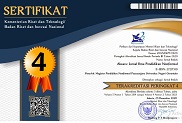Analisis Kluster Terpaan Selektif Dalam Jaringan Informasi Vaksin Covid-19 Di Twitter
Abstract
Tujuan penelitian ini adalah untuk mengedintifikasi kluster yang terbentuk dalam jaringan twiter terkait dengan topik-topik vaksin covis-19. Penelitian ini menggunakan pendekatan kuantitatif dengan analisis jaringan sosial dengan metode kluster terpaan selektif. Populasi penelitian ini adalah penggunan jaringan sosial twiter dengan kata kunci “vaksin covid-19’ sebagai sampel kluster. Data dikumpulkan dengan menggunakan aplikasi NodeXL. Data dianalisis dengan cara pengelompokan berdasarkan kluster algoritma Clauset-Newman-Moore dengan cara menghitung seluruh jaringan pengguna, tingkat hub dalam kluster, pengelompokan dalam jaringan, menetukan jaringan twiter tertinggi. Hasil penelitian menunjukkan bahwa akun-akun resmi pemerintah, tokoh politik, dan media massa secara bersamaan muncul pada seluruh kumpulan data sehingga mereka membentuk kluster secara konsisten mendukung keberhasilan program vaksinasi nasional.
Keywords
Full Text:
PDFReferences
Cangara, H. (2014). Pengantar Ilmu Komunikasi. PT. Raja Grafindo Persada.
Festinger, L. (1957). A theory of social cognitive dissonance. Standford University Press.
Festinger, L. (1968). Theory Cognitive Dissonance. Standford University Press.
Hansen, D. L., Shneiderman, B., & Smith, M. A. (2011). Analyzing Social Media Networks with
NodeXL: insights From a Connected World. Morgan Kaufmann.
http://site.ebrary.com/lib/alltitles/docDetail.action?docID=10408229%5Cnhttp://www.ama
zon.com/gp/product/0123822297?ie=utf8&tag=conneactio-
&linkcode=as2&camp=1789&creative=390957&creativeasin=0123822297
Holmes, D. E. (2017). Big Data: A Very Short Introduction. Oxford University Press.
Prior, M. (2007). Post-Broadcast Democracy. Cambridge University Press.
https://doi.org/10.1017/CBO9781139878425
Sloan, L., Quan-Haase, A., Mayr, P., & Weller, K. (2017). The SAGE Handbook of Social Media
Research Methods. In M. Steele (Ed.), The SAGE Handbook of Social Media Research
Methods. Sage Publication Ltd. https://doi.org/10.4135/9781473983847.n8
Sugiyono. (2013). Metode Penelitian Kuantitatif Kualitatif dan R&D. Alfabeta.
Stroud, N. J. (2014). Selective Exposure Theories. The Oxford Handbook of Political
Communication, 1(July), 1-21. https://doi.org/10.1093/oxfordhb/9780199793471.013.009
Daring
Afifah, M. N. (2021). Kenali Arti Efikasi Vaksin, Berbeda dari Efektivitas. Kompas.Com.
Kawalcovid19.id. (2021). Kawal informasi seputar COVID-19 secara tepat dan akurat.
Namira, I. (2020). 7 Fakta “Ngeri†Filter Bubble, Gelembung Virtual Penyaring Informasi.
Idntimes.Com. https://www.idntimes.com/tech/trend/izza-namira-1/fakta-filter-bubble/1
Neuron. (2021). Apa Bedanya 5 Vaksin Korona Ini? Youtube.
Pusparisa, Y. (2021). Daftar Negara Pengguna Smartphone Terbanyak, Indonesia Urutan
Berapa? Databoks.Katadata.Co.Id.
https://databoks.katadata.co.id/datapublish/2021/07/01/daftar-negara-penggunasmartphone-
terbanyak-indonesia-urutan-berapa
Putri, V. K. M. (2021). Hyperlink: Pengertian, Jenis, Fungsi dan Cara Membuatnya.
Kompas.Com.
Sekretariat Kabinet Republik Indonesia. (2021). Presiden Jokowi Terima Suntukan Dosis
Pertama Vaksin COVID-19. https://setkab.go.id/presiden-jokowi-terima-suntikan-dosispertama-
vaksin-covid-19/
Twitter. (2021). Twitter API.
Ensiklopedia
Gruzd, A. (2014). Encyclopedia of Social Network Analysis and Mining. In Encyclopedia of
Social Network Analysis and Mining. https://doi.org/10.1007/978-1-4614-6170-8
Jurnal
Acter, T., Uddin, N., Das, J., & Akhter, A. (2020). Evolution of severe acute respiratory syndrome
coronavirus 2 (SARS-CoV-2) as coronavirus disease 2019 (COVID-19) pandemic: A global
health emergency. Science of the Total Environment Journal, N/V(January), 2-15.
https://doi.org/https://dx.doi.org/10.1016%2Fj.scitotenv.2020.138996
Adriana, Z. (2015). Communication Pattern Instructor Use of Cyber Extension at Secretariat
Agency Coordination Counseling Province Riau. JOM, 2(1).
Anggarini, S. (2020). Fenomena Dalam Berita Covid-19. Jurnal Audience, 3(2), 224-249.
https://doi.org/10.33633/ja.v3i2.3628
Arora, P. (2012). Typology of Web 2.0 spheres: Understanding the cultural dimensions of social
media spaces. Current Sociology, 60(5), 599-618.
https://doi.org/10.1177/0011392112440439
Aruguete, N., & Calvo, E. (2018). Time to #protest: Selective exposure, cascading activation, and
framing in social media. Journal of Communication, 68(3), 480-502.
https://doi.org/10.1093/joc/jqy007
Barberá, P., Jost, J. T., Nagler, J., Tucker, J. A., & Bonneau, R. (2015). Tweeting From Left to
Right. Psychological Science, 26(10), 1531-1542.
https://doi.org/10.1177/0956797615594620
Emarita, N., Suryana, A., & Aristi, N. (2012). Hubungan antara Pencarian Informasi Melalui
Twitter @BdgBerkebun dengan Pemenuhan Kebutuhan Informasi. Jurnal Manajemen
Komunikasi Fakultas Ilmu Komunikasi Universitas Padjajaran, 1(1), 1-14.
Felt, M. (2016). Social media and the social sciences: How researchers employ Big Data analytics.
Big Data and Society, 3(1), 1-15. https://doi.org/10.1177/2053951716645828
Freedman, J. L., & Sears, D. O. (1965). Selective Exposure. Advances in Experimental Social
Psychology, 2(C), 57-97. https://doi.org/10.1016/S0065-2601(08)60103-3
Gruzd, A., & Mai, P. (2020). Going viral: How a single tweet spawned a COVID-19 conspiracy
theory on Twitter. Big Data and Society, 7(2). https://doi.org/10.1177/2053951720938405
Hardianto, G., Erlamsyah, E., & Nurfahanah, N. (2016). Hubungan antara Self-Efficacy
Akademik dengan Hasil Belajar Siswa. Konselor, 3(1), 22.
https://doi.org/10.24036/02014312978-0-00
Himelboim, I., Smith, M., & Shneiderman, B. (2013). Tweeting Apart: Applying Network
Analysis to Detect Selective Exposure Clusters in Twitter. Communication Methods and
Measures, 7(3), 169-197. https://doi.org/10.1080/19312458.2013.813922
Himelboim, I., Xiao, X., Lee, D. K. L., Wang, M. Y., & Borah, P. (2020). A Social Networks
Approach to Understanding Vaccine Conversations on Twitter: Network Clusters,
Sentiment, and Certainty in HPV Social Networks. Health Communication, 35(5), 607-615.
https://doi.org/10.1080/10410236.2019.1573446
Islam, A. K. M. N., Laato, S., Talukder, S., & Sutinen, E. (2020). Misinformation sharing and
social media fatigue during COVID-19: An affordance and cognitive load perspective.
Technological Forecasting and Social Change, 159, 120201.
https://doi.org/10.1016/j.techfore.2020.120201
Jonas, E., Schulz-Hardt, S., Frey, D., & Thelen, N. (2001). Confirmation bias in sequential
information search after preliminary decisions: An expansion of dissonance theoretical
research on selective exposure to information. Journal of Personality and Social
Psychology, 80(4), 557-571. https://doi.org/10.1037/0022-3514.80.4.557
Khaerunnisa Syafitri, N., Rullyana, G., & Ardiansah, A. (2020). autobase@collegemenfess, A
Twitter Account Used as Information Retrieval Tool. Khizanah Al-Hikmah: Jurnal Ilmu
Perpustakaan, Informasi Dan Kearsipan, 8(2), 161-172.
https://doi.org/10.24252/kah.v8i2a6
Kitchin, R. (2014). Big Data, new epistemologies and paradigm shifts. Big Data and Society, 1(1),
-12. https://doi.org/10.1177/2053951714528481
Kitchin, R., & McArdle, G. (2016). What makes Big Data, Big Data? Exploring the ontological
characteristics of 26 datasets. Big Data and Society, 3(1), 1-10.
https://doi.org/10.1177/2053951716631130
Knobloch-Westerwick, S., Johnson, B. K., & Westerwick, A. (2013). To your health: Self-
Regulation of health behavior through selective exposure to online health messages. Journal
of Communication, 63(5), 807-829. https://doi.org/10.1111/jcom.12055
Kurniawan, R., & Apriliani, A. (2020). ANALISIS SENTIMEN MASYARAKAT TERHADAP
VIRUS CORONA BERDASARKAN OPINI DARI TWITTER BERBASIS WEB
SCRAPER. Jurnal INSTEK (Informatika Sains Dan Teknologi), 5(1), 67.
https://doi.org/10.24252/instek.v5i1.13686
Lewis, S. C., Zamith, R., & Hermida, A. (2013). Content Analysis in an Era of Big Data: A Hybrid
Approach to Computational and Manual Methods. Journal of Broadcasting and Electronic
Media, 57(1), 34-52. https://doi.org/10.1080/08838151.2012.761702
McGuire, W. J., & Papageorgis, D. (1961). The relative efficacy of various types of prior beliefdefense
in producing immunity against persuasion. The Journal of Abnormal and Social
Psychology, 62(2), 327-337. https://doi.org/10.1037/h0042026
Nasution, B., Rumyeni, R., & Rimayanti, N. (2019). Perilaku Pencarian Informasi Pemilihan
Umum Tahun 2019 Pemilih Pemula di Kota Pekanbaru. Jurnal Komunikatif, 8(2), 191-204.
https://doi.org/10.33508/jk.v8i2.2212
Pambudi, H. J., Nugroho, A. L. A., Handoko, L., & Dianastiti, F. E. (2021). BUZZER DI MASA
PANDEMI COVID-19: STUDI ANALISIS WACANA KRITIS KICAUAN BUZZER DI
TWITTER. Jurnal Masyarakat Dan Budaya, 23(1), 75-89.
https://doi.org/https://doi.org/10.14203/jmb.v23i1.1265
Papacharissi, Z., & De Fatima Oliveira, M. (2012). Affective News and Networked Publics: The
Rhythms of News Storytelling on #Egypt. Journal of Communication, 62(2), 266-282.
https://doi.org/10.1111/j.1460-2466.2012.01630.x
Parks, M. R. (2014). Big Data in Communication Research: Its Contents and Discontents. Journal
of Communication, 64(2), 355-360. https://doi.org/10.1111/jcom.12090
Prastyo, I., Suryanto, & Rini, A. P. (2019). Disonansi Kognitif Wanita Pekerja Seks Komersial
yang Bekerja Menghidupi Keluarga. PSISULA, 1(September), 74-83.
https://doi.org/http://dx.doi.org/10.30659/psisula.v1i0.7693
Riani, N. (2017). MODEL PERILAKU PENCARIAN INFORMASI GUNA MEMENUHI
KEBUTUHAN INFORMASI (STUDI LITERATUR). Publication Library and Information
Science, 1(2), 14. https://doi.org/10.24269/pls.v1i2.693
Rohmiyati, Y. (2018). Model Perilaku Pencarian Informasi Generasi Milenial. Anuva, 2(4), 387.
https://doi.org/10.14710/anuva.2.4.387-392
Saud, M., Mashud, M., & Ida, R. (2020). Usage of social media during the pandemic: Seeking
support and awareness about COVID-19 through social media platforms. Journal of Public
Affairs, 20(4), e02417. https://doi.org/10.1002/pa.2417
Syafganti, I. (2018). Digital Transformation, Big Data and Research Landscape in Digital
Communication. Jurnal Komunikasi Ikatan Sarjana Komunikasi Indonesia, 3(2).
https://doi.org/10.25008/jkiski.v3i2.220
Syarifuddin, M. (2020). ANALISIS SENTIMEN OPINI PUBLIK MENGENAI COVID-19
PADA TWITTERMENGGUNAKAN METODE NAÃVE BAYESDAN KNN. Inti Nusa
Mandiri, 15(1), 23-28. https://doi.org/https://doi.org/10.33480/inti.v15i1.1347
Wei, L., & Hindman, D. B. (2011). Does the digital divide matter more? Comparing the effects
of new media and old media use on the education-based knowledge gap. Mass
Communication and Society, 14(2), 216-235. https://doi.org/10.1080/15205431003642707
Wirawanda, Y., & Wibowo, T. O. (2018). TWITTER: Expressing Hate Speech Behind Tweeting.
Profetik: Jurnal Komunikasi, 11(1), 5. https://doi.org/10.14421/pjk.v11i1.1378
Laporan
Kemp, S. (2021). DIGITAL 2021: INDONESIA.
Wearesocial.com. (2021). Digital 2021.
Prosiding
Duan, W., Cao, Q., Yu, Y., & Levy, S. (2013). Mining online user-generated content: Using
sentiment analysis technique to study hotel service quality. Proceedings of the Annual
Hawaii International Conference on System Sciences, 3119-3128.
https://doi.org/10.1109/HICSS.2013.400
Liao, Q. V., Fu, W. T., & Mamidi, S. S. (2015). Is all about perspective: An exploration of
mitigating selective exposure with aspect indicators. Conference on Human Factors in
Computing Systems - Proceedings, 2015-April, 1439-1448.
https://doi.org/10.1145/2702123.2702570
Tsou, M. H. (2011). Mapping Cyberspace: Tracking The Spread Of Ideas On The Internet. 25th
International Cartographic Conference, 43.
https://icaci.org/files/documents/ICC_proceedings/ICC2011/Oral Presentations PDF/D3-
Internet, web services and web mapping/CO-354.pdf
DOI: http://dx.doi.org/10.37905/aksara.8.1.713-732.2022
Refbacks
- There are currently no refbacks.
Copyright (c) 2022 Aksara: Jurnal Ilmu Pendidikan Nonformal

This work is licensed under a Creative Commons Attribution-ShareAlike 4.0 International License.
Publisher:
Magister Pendidikan Nonformal Pascasarjana Universitas Negeri Gorontalo
Jl. Soedirman No. 06 Gorontalo 96128 e-mail: jurnalaksara@ung.ac.id
http://ejurnal.pps.ung.ac.id







